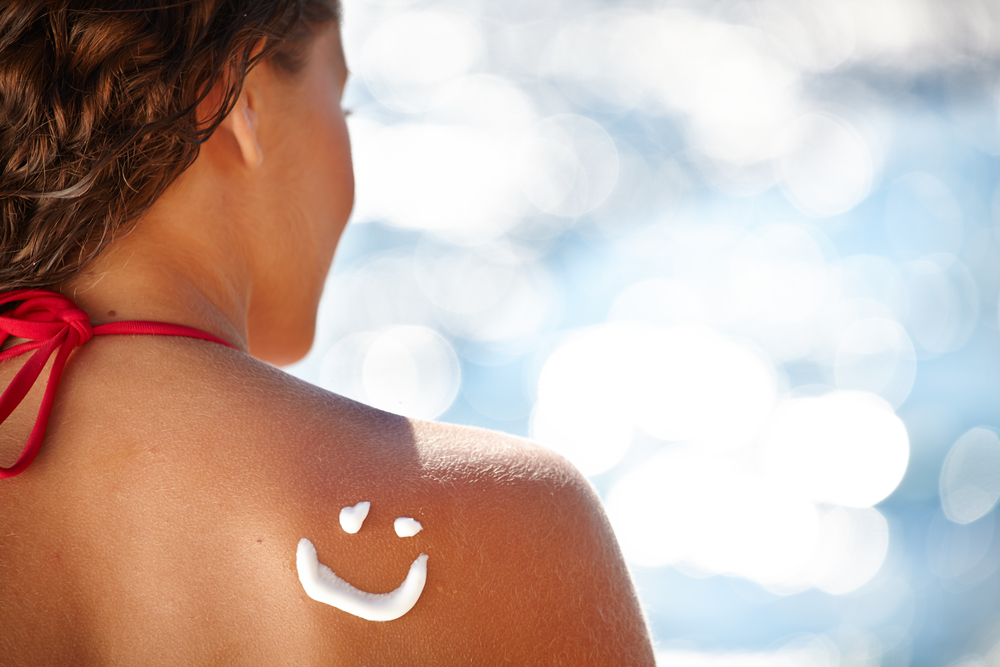I was in the garden with a friend and her 6-month-old baby recently. The second the sun came out, anxiety clouded her face.
She darted inside, reappeared with a bottle of sunscreen, and administered it liberally to the squirming infant, and then to herself.
Not in the habit of offering unsolicited advice, I bit my tongue.
But I was really biting it on this occasion because what I know about conventional sunscreens makes it very hard for me to sit and watch anyone putting such a toxic substance on themselves, let alone on a child.
My friend was just doing what any concerned mother naturally does given what we are told about the sun. She was following the advice of the world’s leading doctors and dermatologists to protect her child from something we are told can cause deadly disease.
But when you stop and think about it, the idea that the sun is bad for us is completely nuts!
Our species evolved in the tropics, under the sun, without houses, clothes, hats or sunscreen.
Skin cancer rates are on the increase yet we get a tiny fraction of the sun exposure our ancestors did. Clearly there is something else at play here.
Did someone say ozone layer? Yes, there are parts of the world (for example, Australia) which have experienced both ozone depletion and an increased incidence of skin cancer, and there is evidence of a link there.
But there are many other parts of the world where skin cancer rates are increasing despite the fact there has been no ozone depletion, so this isn’t the explanation we’re looking for.
For example, skin cancer rates in Norway increased by 350% for men and 440% for women during the period 1955 to 1984. The ozone layer did not change during this period.
Skin cancer was very rare 100 years ago and is still very rare among many populations. For example, there is virtually no skin cancer in Africa, where people stay in the sun all day long without sunscreen.
If you think that’s down to the protective effect of darker skin pigmentation, think again: people with African heritage who live in America have very high rates of skin cancer.
So let’s cut to the chase. What is causing the increase in skin cancer?
A major culprit is the standard western diet. Diets high in harmful fats and low in antioxidants and essential fats have been shown to increase the risk of all cancers, including cancers of the skin.
Eating in this way can cause cancer because of unfavourable changes in our internal biochemistry, but there is an additional way in which it can cause skin cancer.
Sunlight accelerates the release of toxins through the skin, our largest eliminative organ. When excess levels of toxins and cooked fats are pulled to the skin’s surface by the sun they congeal there and are then “fried”, which leads to free radical production.
Free radicals cause DNA damage, which can lead to cancer. The most effective sunscreen of all? A whole foods diet loaded with raw fruit and vegetables.
Inadequate antioxidant levels have been shown to increase the skin’s propensity to burn in the sun, and there is fairly strong evidence of a link between sunburn (not simple sun exposure, but sunburn) and certain types of skin cancer – namely non-melanoma skin cancers such as basal cell carcinoma and squamous cell carcinoma.
These cancers rarely spread to other sites in the body and are rarely fatal. In fact, only around 1 in 1,000 people who contract non-melanoma skin cancer die of the disease, and it accounts for only around 1 in 500 cancer deaths in the west.
Non-melanoma skin cancers are extremely common, but deadlier melanoma is much less so.
There is some evidence that excessive sun exposure increases the risk of melanoma.
But then again, this cancer is more common in people who work indoors than those who work outdoors, and it often forms on areas of the body that get least sun exposure (if any) such as the soles of the feet and the buttocks. Also, few studies have been able to show that sunscreen protects against melanoma.
And that’s not surprising given that incidence of all forms of skin cancer, including melanoma, is highest in those parts of the world where sunscreen use is highest.
Now, just because two things are happening in the same place at the same time doesn’t mean they are linked. The sunscreen industry and the medical establishment tell us that the rates would drop if people would only use more sunscreen.
But given the fact that conventional sunscreens contain numerous carcinogenic substances, it is extremely unlikely it’s a coincidence that skin cancer rates have increased in tandem with their increased use.
Sunscreens contain the following three classes of substances that are linked with cancer:
- Toxic chemicals that accumulate in the body’s fat reserves
- Powerful free radical generators
- Oestrogenic compounds which wreak hormonal havoc
As an example of the second, recent research showed that 97% of all Americans are contaminated with benzophenone, a UV absorber widely used in sunscreens.
Benzophenone is one of the most powerful free radical generators known to man.
Free radicals cause damage to the protein, fat and DNA in our cells, and this damage accelerates aging and can lead to cancer – the very things sunscreens are supposed to be protecting us against.
The oestrogenic effects of sunscreens, meanwhile, are thought to cause certain cancer cells to multiply more rapidly.
There isn’t time to list all of the dangerous substances in conventional sunscreens and their detrimental health effects. However, the important thing to realize is that sunscreens contain a cocktail of chemicals that either damage skin and/or also travel through skin into the bloodstream causing much more widespread damage.
In fact, a large proportion of the active ingredients in sunscreens also act as “penetration enhancers”, meaning they aid the movement of other chemicals through the skin and into the blood.
An additional way in which sunscreens increase cancer risk is by blocking the production of vitamin D in the skin. Numerous studies have shown adequate vitamin D levels to protect against many forms of cancer.
Adequate vitamin D is needed for proper immune functioning, for proper mental and emotional functioning, for bone health, and for many other essential bodily systems and functions.
We are designed to have our needs for it easily met by sunlight yet most of us in the UK are chronically deficient in this nutrient. Living far from our biological niche (that being the tropics), our indoor lifestyle, and sunscreen use are the causes.
Even SPF8 sunscreen blocks 95% of vitamin D production in the skin. So clearly, embalming ourselves in sun “protection” every time we go outside is one of the worst things we can do for our health.
In fact, we are protecting neither our skin nor our health when we do this; rather, we are denying ourselves powerful natural protection we’re designed to get from the sun.
Allowing sunlight on our skin doesn’t cause skin cancer. That’s like saying that allowing air in our lungs causes lung cancer.
We need sunlight on our skin.
Other factors need to be present for the sun to cause skin cancer: a poor diet and/or conventional sunscreen use, plus excessive sun exposure.
As we’ve established, conventional sunscreens don’t decrease cancer risk – they increase it. But what about natural, non-toxic sunscreens?
Well, the answer is that we should only use them if we are reasonably sure that we have exposed enough skin to the sun for long enough to ensure adequate vitamin D levels.
Opinions as to how much skin this involves, and for how long, vary. But given that we were designed to live outdoors, in the tropics, it’s wise to err on the side of more exposure, not less – as long as you are careful not to let your skin burn.
So I’m quoting here the highest recommended exposure I’ve come across, though I’m personally convinced we need more, even, than this for optimal physical, mental, emotional and spiritual health.
- Light-skinned people need to expose 85% of skin to the midday sun for 10-20 minutes a day
- Dark-skinned people need to expose 85% of skin to the midday sun for 90-120 minutes a day
(Note: if you are in the UK like I am, the above amounts may stand you in good stead from April to September. But during the other six months of the year you’ll need to look to diet and supplementation to top up your vitamin D levels, unless you can relocate somewhere sunnier. The body has only limited ability to store vitamin D so no amount of summer sun will carry you through a UK winter).
The take-home advice about safe sun exposure
- Unless you are consistently getting the above amount of sun on your skin, consider skipping the sunscreen altogether. But don’t ever let your skin burn. Get to know your skin and if you ever suspect it is starting to burn, either get inside, cover up, or apply a natural, non-toxic sunscreen.
- If you want to make the most of the sun by staying out in it as long as possible, wearing as little as possible, you’ll want to go for the third option above any time protection is needed and use a natural sunblock or sun protection cream.
- If your skin is sensitive to the sun, load up on antioxidants. This alone can enable you to enjoy safe sun exposure for longer without external protection as your skin will be protected from the inside.
- Consider taking natural sun protection with you if you are going on holiday somewhere with higher-intensity sun than you’re used to. You never know when you might need it and chances are you won’t be able to buy it there. You will most likely only be able to find conventional toxic brands (and those may be a lot worse than the label lets on, since in many countries sunscreen manufacturers don’t even have to list all ingredients). So stock up before you go, and err on the side of taking more rather than less.
- Another reason you might choose to use sunscreen is to prevent photo-aging of the skin. Although the sun is not bad for you, it does cause wrinkles and lines. Those aren’t bad for you either, but if you prefer to avoid them you might want to apply a natural, non-toxic sunscreen to your face and neck whenever you are out in the sun.
However, remember the “85% rule” above: if sunscreen is blocking vitamin D production in the skin on your face and neck you may need to stay in the sun for longer than the times listed above – unless you are wearing nothing but a smile!




